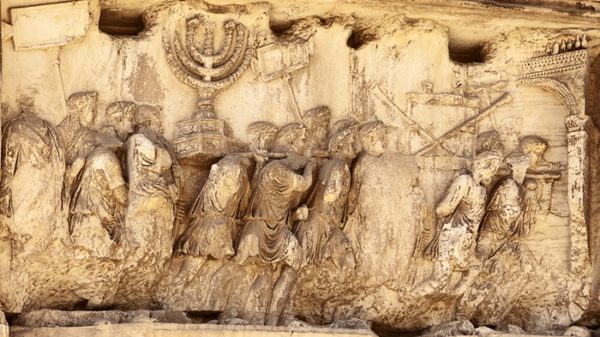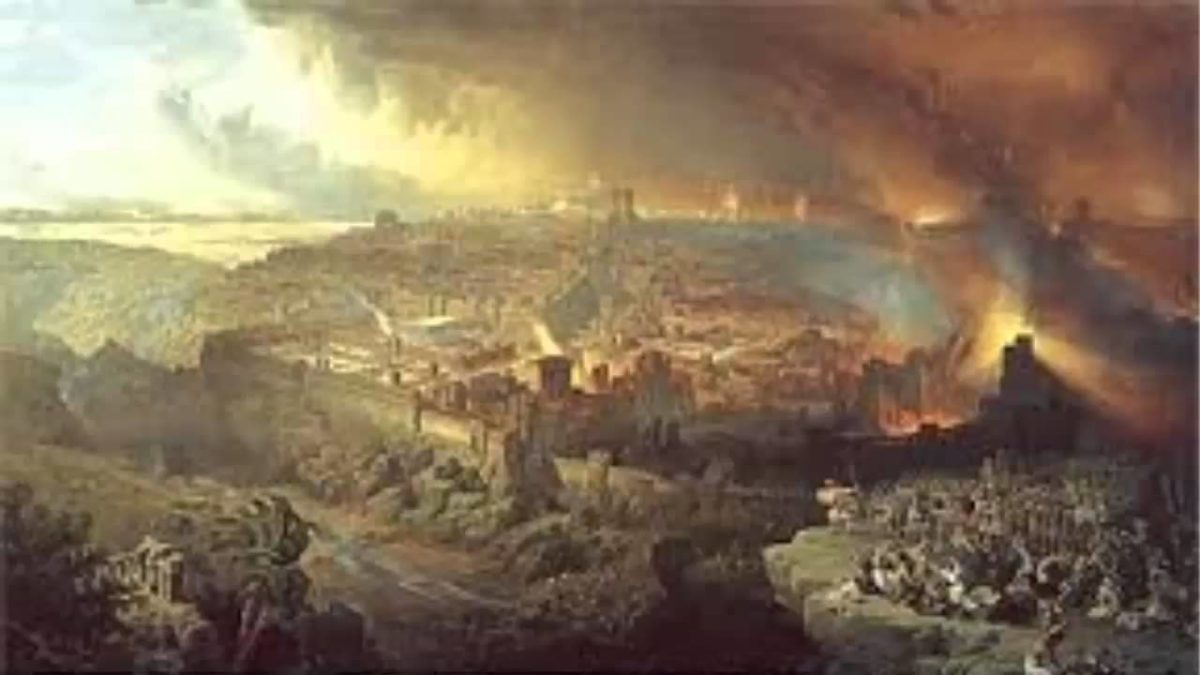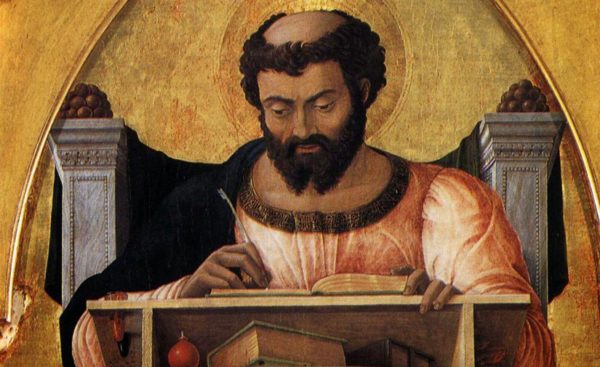Recently we’ve been looking at the question of when the Gospel of Matthew was composed.
In our first post, we argued that Matthew was written sometime between A.D. 55 and 100, and since then we’ve been trying to narrow down the range.
A key event falling in the middle of this period was the conquest of Jerusalem and the destruction of its temple in A.D. 70.
In our previous post, we looked at arguments that Matthew was written after this traumatic event and found that they lack force.
But do we have reasons to think that the Gospel was written before 70?
Let’s look at the evidence . . .
Authorship by the Apostle?
The external evidence found in the writings of the Church Fathers is strongly in favor of the Apostle Matthew as the author of the Gospel attributed to him.
Some have argued that it would be unlikely for Matthew to have written after A.D. 70, meaning it had an earlier date than this.
I’ve studied the likely ages of the apostles, and it can be reasonably estimated that Matthew was born sometime around A.D. 4. He thus would have been in his 60s when Jerusalem was destroyed, and that’s by no means an unreasonable age for an author in the ancient world.
While it’s true that the ancients had shorter lifespans than ours, this is primarily due to the high infant mortality rate. Anyone who survived to adulthood—like Matthew—would have a lifespan almost equal to our own. Thus Raymond Brown, SJ, comments:
Most who think that the apostle Matthew himself wrote the Gospel tend toward a pre-70 dating (although obviously the apostle could have lived till later in the century) (An Introduction to the New Testament, 216).
Similarly, D. A. Carson and Douglas Moo observe:
If the apostle Matthew is judged, on balance, to be the evangelist, a date before A.D. 70 is more plausible (though certainly not necessary—there is excellent evidence that the apostle John was active for at least two decades after 70) (An Introduction to the New Testament, 2nd ed, 155).
The argument thus has some weight, but it is far from decisive.
Passages Presupposing the Temple?
Matthew contains a number of passages that envision the temple as still functioning:
If you are offering your gift at the altar, and there remember that your brother has something against you, leave your gift there before the altar and go; first be reconciled to your brother, and then come and offer your gift (Matt. 5:23-24).
Have you not read in the law how on the sabbath the priests in the temple profane the sabbath, and are guiltless? (Matt. 12:5).
He who swears by the altar, swears by it and by everything on it; and he who swears by the temple, swears by it and by him who dwells in it (Matt. 23:20-21).
It could be argued that Matthew is simply quoting things Jesus said during his ministry and that this has no further significance, but that is open to challenge.
We need to ask the question: Why did Matthew choose to record these things, of all the Jesus traditions he had at his disposal? Surely, he thought they were relevant to his audience, and they would be more relevant if the temple were still standing.
The first and the last, especially, would be more relevant to his audience of Jewish Christians if the temple were standing, because otherwise they could not go to Jerusalem and offer a gift at the altar—nor would they be tempted to swear by an altar or a temple that had been demolished as a result of God’s judgment.
These passages thus add weight to the case for a pre-70 date.
The Temple Tax
A passage deserving special note is the one dealing with the temple tax:
When they came to Capernaum, the collectors of the half-shekel tax went up to Peter and said, “Does not your teacher pay the tax?”
He said, “Yes.” And when he came home, Jesus spoke to him first, saying, “What do you think, Simon? From whom do kings of the earth take toll or tribute? From their sons or from others?”
And when he said, “From others,” Jesus said to him, “Then the sons are free. However, not to give offense to them, go to the sea and cast a hook, and take the first fish that comes up, and when you open its mouth you will find a shekel; take that and give it to them for me and for yourself” (Matt. 17:24-27).
Jesus thus implies that he and Peter do not need to pay the temple tax but should do so anyway to avoid giving offense.
The reason this is significant for our purposes is not just that Jewish Christians wouldn’t need to pay the temple tax once the structure was in ruins, it is that the Romans repurposed the tax so that it supported the temple of Jupiter Best and Greatest—i.e., the Capitoline Temple in Rome! The Jewish historian Josephus reports:
He [Domitian] also laid a tribute upon the Jews wheresoever they were and enjoined every one of them to bring two drachmae every year into the Capitol, as they used to pay the same to the temple at Jerusalem (Jewish War 7:6:6[218]).
Similarly, the Roman historian Cassius Dio states:
From that time forth it was ordered that the Jews who continued to observe their ancestral customs should pay an annual tribute of two denarii to Jupiter Capitolinus (Roman History 65:7:2).
Some Jews tried to avoid paying this tax (which amounted to just two days’ wages), even by the expedient of posing as Gentiles. Yet payment was rigorously enforced, at times in humiliating ways. The Roman historian Suetonius reports:
Besides other taxes, that on the Jews was levied with the utmost rigor, and those were prosecuted who without publicly acknowledging that faith yet lived as Jews, as well as those who concealed their origin and did not pay the tribute levied upon their people. I recall being present in my youth when the person of a man ninety years old was examined before the procurator and a very crowded court, to see whether he was circumcised (The Twelve Caesars “Domitian” 12:2).
Diverting tax money that originally supported the temple in Jerusalem to support the key temple in Rome was an enormous insult to Jewish sensibilities, and the fact they were forced to pay it was a profound humiliation.
For Matthew—if he was writing after A.D. 70—to portray Jesus as condoning the payment of this tax would have risked confusing, alienating, or outraging members of his audience. Jesus could even be understood as financially supporting idolatry so as “not to give offense”!
The inclusion of the passage in his Gospel is far more understandable if Matthew were writing before 70, when Jewish Christians still needed to wrestle with the question of whether to support the temple whose officials had rejected and crucified Jesus and whose destruction he had prophesied. Carson and Moo state:
Even if for other reasons Matthew had wanted to preserve this pericope, it is hard to see how, if he was writing after 70, he could have permitted such an implication without comment (p. 156).
An Exhortation to Pray
Matthew 24 contains a major prophetic discourse dealing with the events leading up to the destruction of the Jerusalem temple.
During the course of the discourse, Jesus says that when the abomination of desolation spoken of by Daniel appears “standing in the holy place” that those in Judea are to “flee to the mountains” (Matt. 24:15-16). He warns them to flee immediately, not going back for anything, and then he says:
Pray that your flight may not be in winter or on a sabbath (Matt. 24:20).
It is well known that the Christian community in Jerusalem did flee the Jewish War, taking up residence in the Jordanian settlement of Pella (Eusebius, Church History 3:5:3).
Like all ancient authors, Matthew was conscious of the need to save space in his book so that it would fit on a single scroll, and he regularly drops words and phrases from Mark for just this reason.
So why would he preserve this exhortation to Judean Christians to pray that their flight not take place in winter or on a sabbath (when travel would be difficult) if the flight had already occurred and the need to pray no longer existed?
No Fulfillment Notice
Another, even weightier aspect of Matthew 24 is the fact that it’s Jesus’ major prophetic discourse in the Gospel, and it’s focused on the destruction of the temple, which Jesus predicts at the very beginning of the chapter (Matt. 24:1-2).
Despite the fact this is Jesus’ longest prophecy, and thus of great importance to Matthew, he nowhere records that it has been fulfilled.
This requires explanation. The Evangelists regularly report it when Jesus made a prophecy that was later fulfilled, as it shows his credentials as a true prophet.
Thus when they record Jesus predicting his arrest, death, and resurrection, the Evangelists correspondingly report these prophecies being fulfilled.
Matthew, of all the Evangelists, is especially noted for including prophetic fulfillment notices in his Gospel (Matt. 1:23, 2:6, 17, 23, 3:3, 4:14-16, 13:14).
Similarly, Matthew breaks the flow of his narrative to report on conditions in his own day (Matt. 27:8, 28:15).
In view of these factors, we would expect Matthew in particular, of all the Evangelists, to comment on the fulfillment of Jesus’ prophecy concerning the temple. As the German scholar Theodor Zahn commented:
If “to this day” (27:8, 28:15) were after the destruction of Jerusalem and the temple, we would expect that an author who values so highly as does Matthew proof based upon the occurrence of prophecy and its fulfilment for the justification of Christ over against Judaism, would indicate somewhere and in some manner that the prophecy of Jesus had been fulfilled in this judgment (Introduction to the New Testament, 571).
Yet he does not do so. This puts the destruction of the temple in the same category as other yet-to-be-fulfilled prophecies, such as the Second Coming.
Particularly in light of the space Matthew devotes to the prophecy, the fact he does not give us a fulfillment notice strongly argues for a pre-70 date.
No Disentanglement
Even more striking, Matthew makes no attempt to disentangle the Second Coming from the events leading up to the temple.
Each of the Synoptic Gospels speaks of there being a “coming” of Jesus in the discourse about the temple’s destruction (Matt. 24:30, Mark 13:26, Luke 21:27).
In my view, this was not the Second Coming but a coming in judgment, as when the Old Testament describes God “riding the clouds” when he comes in judgment on a people (Ps. 104:3; Isa. 19:1-2; Jer. 4:13-14).
However, to the first Christians (and many since), it would have been easily confused with the Second Coming of Christ.
We would thus expect the Evangelists—if they were writing after 70—either to drop the references to this coming from the discourse or to somehow clarify for the audience that it wasn’t the Second Coming.
To fail to do this could scandalize the audience by making it look like Jesus predicted the Second Coming at a time when it failed to occur.
Yet they do not do so. Contemporary scholar Donald Hagner comments:
Matthew’s redaction of the Markan eschatological discourse makes no attempt to disentangle the references to the fall of Jerusalem and the end of the age (chap. 24). Luke very deliberately does so in his redaction of Mark 13, and we might expect Matthew to do the same had it been written after 70. Indeed, the evangelist aggravates the problem considerably by his insertion of eutheôs, “immediately,” in 24:29, which leaves the clear impression that he expected the parousia of the Son of Man to occur in close succession to the fall of Jerusalem (Word Biblical Commentary, Matthew 1-13, vol. 33A, lxxiv).
The fact that the Synoptic Evangelists neither drop the “coming” language nor clarify that it doesn’t refer to the Second Coming strongly implies that they—Matthew included—were writing before the destruction of the temple.
That would indicate that Matthew’s Gospel was written sometime between Mark—around A.D. 55—and the destruction of the temple in 70.
But can we be more specific? That’s what we’ll look at in our next and final post on Matthew’s date.






 The Dead Sea is a mysterious place. Its name invokes one of the greatest mysteries—death—and there is a good reason for that.
The Dead Sea is a mysterious place. Its name invokes one of the greatest mysteries—death—and there is a good reason for that. After the Bedouin’s initial discovery, a survey was eventually undertaken, and scholars found ten more caves containing scrolls. Today they are numbered Caves 1 to 11.
After the Bedouin’s initial discovery, a survey was eventually undertaken, and scholars found ten more caves containing scrolls. Today they are numbered Caves 1 to 11.
 Something very strange happens in John’s Gospel.
Something very strange happens in John’s Gospel.